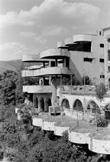KELLY WRITERS HOUSE
Erika Tapp
MOSTAR/SARAJEVO:
MODERNIST RUINS
CURATOR
STATEMENT:
poModReDUX
By Peter Schwarz
During these fragmented Balkan Wars, indicted Serbian war criminal
Slobodan Milosevic acted more like a postmodernist warlord than a 20th
Century modernist totalitarian like Hitler or Stalin (yes or no, as
Western politicians debated then); while some will undoubtedly argue that
Milosevic's "Greater Serbia" dream echoed Hitler's lebensraum, thus
qualifying him for modernism's category of tyrant, Milosevic's nationalism
is a postmodernist discourse: his control and use of mass media to
opiatize his subjects while glamorizing his nationalistic "celebrity"
image; trumpeting ethnic superiority while simultaneously attempting to
create a homogenous and feudalistic society that cannot escape its
heterogeneous influences; his reign as a macabre parody of his earlier
20th Century totalitarian predecessors. These are several examples of the
intricate modernist-postmodernist dialogues that erupted into a savage war
during which, for the first time since 1945, concentration camps
(Prijedor, Omarska) appeared on European soil. The previous Balkan Wars
are a significant factor symbolizing the need to move beyond
postmodernism.
Mostar/Sarajevo: Modernist Ruins presents three voices: the damaged
architecture as nonverbal testimony; Erika Tapp's intention to restore
Bosnian modernist architecture to our attention while capturing the
resilience of life emerging among the ruins as the ongoing project of
Bosnian postwar reconstruction continues. (The most evocative image of the
second voice is "Trolley ride through Sarajevo", infamously called
"sniper's alley" during the war and a thoroughfare that claimed many
civilian lives.) The third, curatorial voice completes the process of
cultural production by creating a discourse worthy of the works that
engages the viewer on the complex levels present in this exhibit.
Mostar/Sarajevo: Modernist Ruins is a collection of visual
documents not
only of the subjects depicted, preserved as archive, but also as one
collective document of an event that reveals the breaking point with
postmodernism for what will follow afterwards:
does the earth know language
does the sky reproach the minaret?
Songs cascade through the present centuries, these lyric struggles entombed in mass graves,
the Great Schism is a line drawn in the mind
observed by bleached stone markers
engraved
with the names of the Holocaust's heirs—
Six hundred years and Prince Lazar regains his head, the scattered legions
clamor black birds fly again above Barbarian hordes, Huns or Goths the
plunder is the same voice
Ilyrian Latin or Bosnian
We did not burn Saint Sava
accused heretics plead
Turk! Turk!
Zupanis scream
Who is the Turk Obrenovic!
Reichstag burns red flag rises over the Kaiser's broken eagle,
the Imperial Viennese are cross-caste lovers Admira Bosko
who don't reach Trieste
This land is steeped in the blood of stories—
As old as Celtic memories
burning in the paleolithic night
King Gavrilo is crowned
Howls break the darkness
into trade routes leading through Occident lusts
and wine tears
Passions play on the road to Calvary's mosques,
salvation smoldering in the eyes of bearded patriarchs anointing their apostles
Incense fogs
the taste of rose water splashing Dalmatian shores—
The women of Bogomil and their stolen bodies
thieved from their Magyar lovers into Orthodox harems,
these daughters of Sultan's mistresses seeping rose-petal jam
while bearing Slobo's salty seed
A fief for a piper's
song of honey and plums.
© Peter Schwarz 2002
The architecture on display is modernist, yet my exhibit commentary is a
"post-postmodernist" discourse situating the specificity of Erika Tapp's
photography within the conceptual framework of the Balkan Wars.
Postmodernism is not a distinct rupture with modernism, but is the last
stages of modernism playing itself into its present state of exhaustion. I
also implicate postmodernism as an instigating factor in the 1991-1995
Balkan Wars, a cultural "movement" that is contributing to the current
cultural fragmentation characteristic of globalization. While this exhibit
refers to Yugoslav modernist architecture, engagement on the aesthetic and
political levels is approached from postmodernist and "post-postmodernist"
perspectives.
